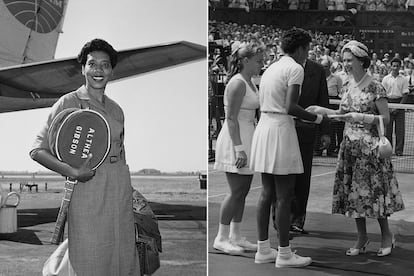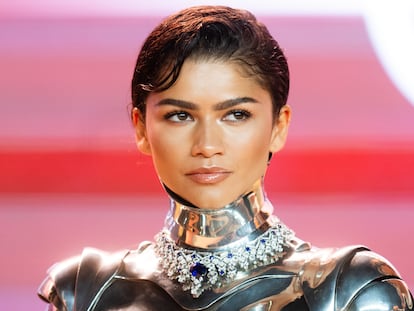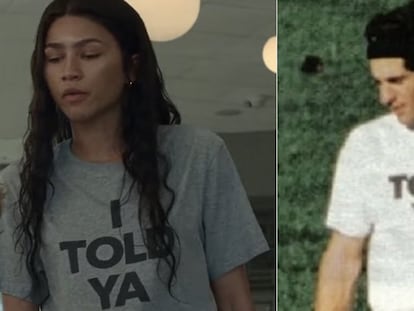Zendaya’s new look pays tribute to Althea Gibson, the first African-American tennis player to win a Grand Slam
The sports brand On has come up with a replica of the outfit worn by the South Carolina tennis player, who won the French Championships, Wimbledon and the US Open

In December 2014, actress and singer Zendaya shared this motivational quote on her Twitter account (now X): “No matter what accomplishments you make, somebody helped you.” It was said by Althea Gibson, a tennis player who broke through racial barriers by becoming the first African-American to win a Grand Slam. Born in Silver, South Carolina, in 1927, she became a phenomenon in the 1950s, winning trophies at the French International Tennis Championships, now known as Roland Garros, Wimbledon and the US Open. Almost 70 years later, she continues to be a role model, one which Zendaya is paying tribute to by wearing a Gibson-style tennis kit as she promotes her new sport/romance movie Challengers: pleated skirt, white sneakers and sleeveless polo.
Zendaya’s stylist, Law Roach confirmed on his Instagram account that this outfit, worn by Zendaya in Monaco, has a story behind it. “THANK YOU to the team at @on running for recreating the ICONIC tennis white of Althea Gibson,” wrote Roach, who posted a photo of the actress wearing the threads designed for her by the Swiss sportswear brand On, as well as images of Gibson in the outfit that inspired the design.
Directed by Luca Guadagnino, whose Desire trilogy includes Call Me By Your Name, Zendaya’s latest film Challengersuses the world of tennis as a backdrop for a love triangle between her character and those of Josh O’Connor and Mike Faist. Zendaya plays a tennis coach who was once considered the best player in the world and who orchestrates a sporting encounter between her husband and her former boyfriend. To promote the movie, the actress has dyed her hair blonde and worn a wardrobe with tennis motifs as she rocks up at premieres from Sydney to Milan and London.

Like Zendaya’s character in Challengers, Althea Gibson was recognized as one of the great players of her time. She was born into a family that worked in cotton just when the cotton market collapsed in the 1920s, prompting a move to New York. Gibson grew up in Harlem and, by the age of 12, began to stand out as an athlete. Soon she was wielding a racket on the city’s tennis courts and, in 1950, became the first African-American player to compete in the US national championships, at a time when racial segregation was the order of the day.
Her career then went from strength to strength: in 1956 she won the French International Tennis Championships and in 1957 she was awarded her first individual trophy at Wimbledon as well as winning the US Open. “She was able to pave the way for me to have an opportunity to play and do the best that I can,” said tennis ace Serena Williams, when she was compared to Gibson following her first round win at Wimbledon in 2015. Winner of 23 singles titles in Grand Slam tournaments, Williams expressed her admiration for her predecessor, but denied she was her successor, pointing out that Gibson had a lot more obstacles to contend with as a black woman in the world of tennis at that time. “I think Althea Gibson had a wonderful career, being the first African-American to win a Grand Slam,” she said. “I don’t see myself as her successor because she went through so much. I read a lot about her, how she had to sleep in cars because she wasn’t allowed to stay in hotels. I’ve never had to go through those trials or tribulations.”

“I always wanted to be somebody,” Gibson is quoted as saying on Washington’s National Museum of African American History and Cultures’ website. “If I made it, it’s half because I was game enough to take a lot of punishment along the way.”
The museum preserves some of Gibson’s rackets and flags up her achievements beyond the tennis court: “In 1967 she also became the first African American women to compete on the Ladies Professional Golf Association tour. After her playing days ended, Gibson remained a trailblazer. She became the country’s first woman state athletic commissioner in 1976,” the website states.
A few years earlier, in 1971, Gibson’s achievements were recognized when she was inducted into the International Tennis Hall of Fame and, in 2013, a stamp was issued in the US to commemorate the athlete, who died in 2003 at the age of 76.

Tu suscripción se está usando en otro dispositivo
¿Quieres añadir otro usuario a tu suscripción?
Si continúas leyendo en este dispositivo, no se podrá leer en el otro.
FlechaTu suscripción se está usando en otro dispositivo y solo puedes acceder a EL PAÍS desde un dispositivo a la vez.
Si quieres compartir tu cuenta, cambia tu suscripción a la modalidad Premium, así podrás añadir otro usuario. Cada uno accederá con su propia cuenta de email, lo que os permitirá personalizar vuestra experiencia en EL PAÍS.
¿Tienes una suscripción de empresa? Accede aquí para contratar más cuentas.
En el caso de no saber quién está usando tu cuenta, te recomendamos cambiar tu contraseña aquí.
Si decides continuar compartiendo tu cuenta, este mensaje se mostrará en tu dispositivo y en el de la otra persona que está usando tu cuenta de forma indefinida, afectando a tu experiencia de lectura. Puedes consultar aquí los términos y condiciones de la suscripción digital.
More information
Archived In
Últimas noticias
There is as much life left to discover on planet Earth as that which is already known
Dozens presumed dead, around 100 injured in fire at Swiss Alps bar during New Year’s celebration
Is porn for women different from conventional porn? We spoke to those who make it
Cartagena de Indias is sinking: What can the city do to mitigate it?
Most viewed
- Reinhard Genzel, Nobel laureate in physics: ‘One-minute videos will never give you the truth’
- David King, chemist: ‘There are scientists studying how to cool the planet; nobody should stop these experiments from happening’
- Oona Chaplin: ‘I told James Cameron that I was living in a treehouse and starting a permaculture project with a friend’
- Sinaloa Cartel war is taking its toll on Los Chapitos
- The Interoceanic Train, the Mexican alternative to the Panama Canal










































